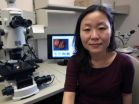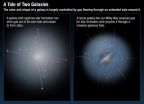(Press-News.org)
EUGENE, Ore. -- Human domestication of soybeans is thought to have first occurred in central China some 3,000 years ago, but archaeologists now suggest that cultures in even earlier times and in other locations adopted the legume (Glycine max).
Comparisons of 949 charred soybean samples from 22 sites in northern China, Japan and South Korea -- found in ancient households including hearths, flooring and dumping pits -- with 180 modern charred and unburned samples were detailed in the Nov. 4 edition of the online journal PLoS ONE, a publication of the Public Library of Science. The findings, say lead author Gyoung-Ah Lee, an archaeologist at the University of Oregon, add a new view to long-running assumptions about soybean domestication that had been based on genetic and historical records.
"Preserved beans have been carbonized, and that distorts the sizes," Lee said. "So we experimented with modern soybeans, charring them to compare them with historical samples. All the different sizes and shapes of soybeans may indicate different efforts in different times by different cultural groups in different areas."
Experts argue that larger beans reflect domestication, but the transition zone between smaller wild-type soybeans and larger hybridized versions is not understood, Lee said. Small-seeded soybeans indicating wild-type soybeans date to 9,000 years ago. Historical evidence to date shows a close relationship between soybeans and use in China during the Zhou Dynasty, about 2,000 years ago. The new study moves domestication back to perhaps 5,500 years ago.
"Soybeans appeared to be linked to humans almost as soon as villages were established in northern China," said co-author Gary Crawford, a professor of anthropology at the University of Toronto Mississauga, in a news release. "Soybean seems to be a plant that does well in human-impacted habitats. In turn, humans began to learn how tasty soybean was and how useful it was."
Today, of course, soybeans are used as livestock feed and to make cooking oil, tofu, tempeh, edamame and protein powder for human consumption.
The new archaeological evidence, Lee says, should be a springboard for archaeologists, crop scientists and plant geneticists to collaborate on understanding cultural contributions, which may lead them to better soybean characteristics. Cultural knowledge, she said, could fill in gaps that relate to domestication and genetic changes of the legume.
"I think one contribution that archaeologists can make is how peoples in ancient times contributed to our heritage of this viable crop and how we can trace their efforts and the methods to help guide us to make even better crops today," Lee said.
In Lee's homeland of South Korea, the research team uncovered evidence for a cultural selection for larger sized soybeans at 3,000 years ago. The evidence for such dating, which also surfaced in Japan, indicates that the farming of soybeans was much more widespread in times much earlier than previously assumed, researchers concluded.
INFORMATION:
Co-authors with Lee and Crawford were Li Liu of the Stanford University Archaeology Center, Yuka Sasaki of Paleo Labo Co. in Japan, and Xuexiang Chen of Shandong University in China.
The Australian Research Council, Social Sciences and Humanities Research Council of Canada, National Science Foundation of China and the National Science Foundation in the United States supported the research through various grants to the co-authors.
About the University of Oregon
The University of Oregon is among the 108 institutions chosen from 4,633 U.S. universities for top-tier designation of "Very High Research Activity" in the 2010 Carnegie Classification of Institutions of Higher Education. The UO also is one of two Pacific Northwest members of the Association of American Universities.
Sources: Gyoung-Ah Lee, assistant professor, anthropology department, 541- 346-4442, galee@uoregon.edu; Gary Crawford, professor, anthropology department, University of Toronto Mississauga, 905-569-4656, g.crawford@utoronto.ca
Links:
Audio with Gyoung-Ah Lee
What archaeology brings to soybean research:
http://test.uonews.uoregon.edu/sites/all/files/uonews/uploads/Archaeological%20View.mp3
What the record now says:
http://test.uonews.uoregon.edu/sites/all/files/uonews/uploads/Soybean%20Record%20for%20Now.mp3
A need for interdisciplinary research: http://test.uonews.uoregon.edu/sites/all/files/uonews/uploads/Why%20this%20matters.mp3
UO Department of Anthropology: http://pages.uoregon.edu/anthro/
About Gyoung-Ah Lee: http://pages.uoregon.edu/anthro/people/faculty/core-faculty/#lee
Soybean adoption came early by many cultures, archaeologists say
Domestication occurred beyond China's borders and may provide a roadmap to making better crops
2011-11-21
ELSE PRESS RELEASES FROM THIS DATE:
What bacteria don't know can hurt them
2011-11-21
Many infections, even those caused by antibiotic-sensitive bacteria, resist treatment. This paradox has vexed physicians for decades, and makes some infections impossible to cure.
A key cause of this resistance is that bacteria become starved for nutrients during infection. Starved bacteria resist killing by nearly every type of antibiotic, even ones they have never been exposed to before.
What produces starvation-induced antibiotic resistance, and how can it be overcome? In a paper appearing this week in Science, researchers report some surprising answers.
"Bacteria ...
UofL researcher determines how Legionnaires' bacteria proliferate, cause disease
2011-11-21
LOUISVILLE, Ky. – A University of Louisville scientist has determined for the first time how the bacterium that causes Legionnaires' disease manipulates our cells to generate the amino acids it needs to grow and cause infection and inflammation in the lungs. The results are published online today (Nov. 17) in "Science."
Yousef Abu Kwaik, Ph.D., the Bumgardner Endowed Professor in Molecular Pathogenesis of Microbial Infections at UofL, and his team believe their work could help lead to development of new antibiotics and vaccines.
"It is possible that the process we have ...
NASA's Hubble confirms that galaxies are the ultimate recyclers
2011-11-21
New observations by NASA's Hubble Space Telescope are expanding astronomers' understanding of the ways in which galaxies continuously recycle immense volumes of hydrogen gas and heavy elements. This process allows galaxies to build successive generations of stars stretching over billions of years.
This ongoing recycling keeps some galaxies from emptying their "fuel tanks" and stretches their star-forming epoch to over 10 billion years.
This conclusion is based on a series of Hubble Space Telescope observations that flexed the special capabilities of its Cosmic Origins ...
Assembly stand completed for NASA's Webb Telescope flight optics
2011-11-21
GREENBELT, Md. -- The cleanroom at NASA's Goddard Space Flight Center in Greenbelt, Md. has received a giant structural steel frame that will be used to assemble the mirrors and instruments of the James Webb Space Telescope.
"This milestone is important as it marks the transition to the integration and testing phase for the Webb telescope's optical telescope element," said Lee Feinberg, Optical Telescope Element Manager for the Webb telescope at Goddard.
The Webb telescope is the world's next-generation space observatory and scientific successor to the Hubble Space ...
UGA researchers develop 'super' yeast that turns pine into ethanol
2011-11-21
Athens, Ga. – Researchers at the University of Georgia have developed a "super strain" of yeast that can efficiently ferment ethanol from pretreated pine -- one of the most common species of trees in Georgia and the U.S. Their research could help biofuels replace gasoline as a transportation fuel.
"Companies are interested in producing ethanol from woody biomass such as pine, but it is a notoriously difficult material for fermentations," said Joy Doran-Peterson, associate professor of microbiology in the Franklin College of Arts and Sciences.
"The big plus for softwoods, ...
Combo hormone therapy has increased breast cancer risk over estrogen alone
2011-11-21
The debate about using menopausal hormone therapies to relieve symptoms in post-menopausal women has been ongoing. Is the combination therapy of estrogen and progestin better or worse than just giving women estrogen alone? In women who still have a uterus (those who have not had a hysterectomy), progestin counteracts the increased risk of uterus cancer when estrogen is given alone, but at the expense of an increase in breast cancer risk compared to estrogen alone.
Now a study by researchers at UCLA's Jonsson Comprehensive Cancer Center has found that women taking the ...
Recent advance in detonation theory
2011-11-21
A detonation wave is a chemical reaction wave propagating at the velocity of a shock wave along the explosive charge. There is great demand for a detonation model that can accurately simulate the detonation process, which would provide a theoretical basis for highly efficient military destruction, the initiation of an atomic bomb, and calculations relating to the supernova SN Ia explosion. Detonation is complicated in that it involves mechanics, chemistry and thermodynamics simultaneously. The detonation product particles move multi-dimensionally, and there are transport ...
Corals can sense what's coming
2011-11-21
Australian scientists have thrown new light on the mechanism behind the mass death of corals worldwide as the Earth's climate warms.
Coral bleaching, one of the most devastating events affecting coral reefs around the planet, is triggered by rising water temperatures. It occurs when the corals and their symbiotic algae become heat-stressed, and the algae which feed the corals either die or are expelled by the coral.
There have been seven major bleaching events globally in the past 30 years, the most recent being in 2010 across the Indian Ocean and Coral Triangle. Australia's ...
Heart rate recovery predicts clinical worsening in pulmonary hypertension
2011-11-21
Heart rate recovery at one minute after a six-minute walking distance (6MWD) test is highly predictive of clinical worsening and time to clinical worsening in patients with idiopathic pulmonary arterial hypertension (IPAH), according to a new study.
"Ours is the first study to show that heart rate recovery at one minute of rest (HRR1) following a 6MW test is a strong predictor of clinical worsening in IPAH patients," said Omar A. Minai, MD, staff physician in the Department of Pulmonary, Allergy, and Critical Care Medicine at the Cleveland Clinic. "Predicting long-term ...
Metabolic syndrome biomarkers predict lung function impairment after exposure to WTC dust
2011-11-21
Metabolic syndrome biomarkers predict subsequent decline in lung function after particulate exposure, according to new research involving rescue personnel exposed to World Trade Center (WTC) dust.
In a nested case-control study of 327 non-smoking FDNY 9/11 rescue workers, metabolic syndrome biomarkers measured within six months of exposure to WTC dust predicted decline of forced expiratory volume in one second (FEV1) over the next six years.
"Study participants with dyslipidemia, elevated heart rate or elevated leptin levels had a significantly increased risk of developing ...
LAST 30 PRESS RELEASES:
Feeding fungi plant remnants produces tasty protein to fortify vegan, vegetarian diets
New tech reduces false positives from breast ultrasounds
Drone-mounted lab monitors fertilizer runoff in real time
Short, light-intensity exercise boosts executive function and elevates mood in children
Jeonbuk National University researchers reveal new interface engineering strategy for efficient and stable back-contact solar cells
Tyrosinase drives hydroquinone-induced exogenous ochronosis: not HGD inhibition
UMass Amherst chemists develop unique tool for studying RNA
Disappointment alters brain chemistry and behavior
A built-in odometer: new study reveals how the brain measures distance
Stress-related brain signals drive risk of cardiovascular disease in people with depression and anxiety
New details on role of fat transport molecules in Alzheimer’s onset
Study illuminates how an antiviral defense mechanism may lead to Alzheimer’s disease
Spot the males: New gene-editing method could transform mosquito control
AI learns to build simple equations for complex systems
NAU team releases 13 years of detailed U.S. CO2 emissions data
Unveiling how sodium-ion batteries can charge faster than lithium-ion ones
How do childcare tax credits affect children’s long-term health?
Can an electronic nose detect indoor mold?
Do natural disasters have long-term impacts on mortality in older adults?
Modification improves sodium‐ion batteries as an alternative to lithium-ion batteries
Parasports provide a range of benefits for people with cerebral palsy
How does grandparental care affect children’s health?
Why are there so many Nordic mediators?
Young shark species more vulnerable to extinction
Mobile fetal heart monitoring linked to fewer newborn deaths in Tanzania
Bluey’s dad offered professorial chair in archaeology at Griffith University
Beyond small data limitations: Transfer learning-enabled framework for predicting mechanical properties of aluminum matrix composites
Unveiling non-thermal catalytic origin of direct current-promoted catalysis for energy-efficient transformation of greenhouse gases to valuable chemicals
Chronic breathlessness emerging as a hidden strain on hospitals
Paleontologists find first fossil bee nests made inside fossil bones
[Press-News.org] Soybean adoption came early by many cultures, archaeologists sayDomestication occurred beyond China's borders and may provide a roadmap to making better crops




